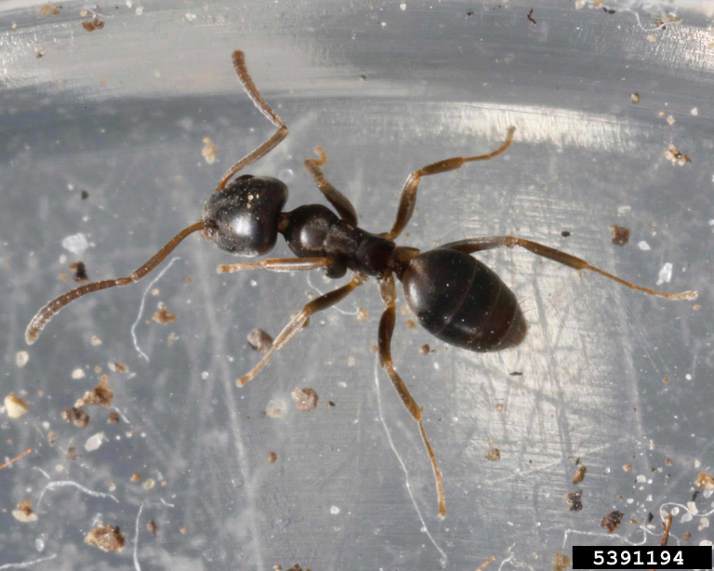 So you just stepped on some little tiny ants marching around in your South Jersey kitchen and all of a sudden there is a sickening sweet smell like a coconut pina colada that has been sitting out for a day or two on the counter. You step on some more and then pull out the over-the-counter pest spray you bought and have a blast spraying every nook and cranny of your kitchen.
So you just stepped on some little tiny ants marching around in your South Jersey kitchen and all of a sudden there is a sickening sweet smell like a coconut pina colada that has been sitting out for a day or two on the counter. You step on some more and then pull out the over-the-counter pest spray you bought and have a blast spraying every nook and cranny of your kitchen.
(Image courtesy of Joseph Berger, Bugwood.org.)
You just killed some Odorous House Ants – also called “coconut ants” or “the sweet ant” – from the rancid coconut smell they release when they are crushed. This smell is a defense mechanism which alerts the other ants in the colony that something is wrong.
The Odorous House Ant or OHA is one of South Jersey’s most common species of nuisance ants and you probably just started an unforeseen chain reaction.
The Odorous House Ant has a keen sense of survival. The ants may avoid the area you sprayed and as a defense against your efforts, the ant colony – hiding deep inside your home – will reproduce at a faster pace and break apart into multiple satellite colonies.
You may believe you solved your ant problem and then the ants will appear in another location of the home.
If you grab that spray can again you will start the cycle all over again.
Odorous House Ants range in color from brown to black, they are small – ranging in length from 1/16 to 1/8 inches, and their antennae have 12 segments.
Outdoors, they build nests in mulch, piles of logs, firewood, boards and other outdoor debris. You may also find them beneath stones, sidewalks , nd concrete slabs.
Indoors, they like to build nests in wall voids, window frames, attic insulation and crawlspace subflooring.
Odorous House Ants feed on the “honeydew” left behind on shrubs by aphids, scale insects and mealy bugs. Honeydew is a sugary substance secreted by these pests. Odorous House Ants invade homes after a rainfall that washes away the honeydew they collect to bring back to feed their colony.
Outdoors these ants live about 50 to a colony with one queen.
Once indoors their colonies explode in size. With an absence of competitors and easier access to food, shelter, warmth and moisture these ants can grow super-colonies with millions of workers and thousands of queens.
Once inside, Odorous House Ants are difficult to remove. Your home is like a large incubator – the longer you wait, the larger the population will become and the longer it will take to control the situation.
Until the colonies are killed the ants will continue to live and grow in the home – and this takes time, patience and a professional exterminator – to determine the type of ant infestation you have and to use the right products that are only available to licensed, trained, professional exterminating companies.
What you can do to keep them out:
- Standing water should be eliminated, as odorous house ants are attracted to moisture.
- Plants should be trimmed back away from the home, so they cannot be used as a bridge to get inside or as a bypass to avoid chemical treatments applied to the ground or foundation walls.
- Cracks, holes, and joints should be sealed with polyurethane foam or caulk, especially those that are near the ground.
- Firewood, rocks, and other materials should not be stored next to a home because it encourages nest building.
What you can do if they are already in:
- Wipe up spills and crumbs immediately.
- Don’t leave open containers of sugars, honey, butter or snacks on countertops or tables.
- Leave pet food out only briefly.
- Clean and empty kitchen garbage cans frequently.
- Repair leaky faucets.
If your efforts to keep ants at bay are not working – we can help to minimize the problem as quickly as possible – Call AB-Con today and have your Odorous House Ant problem solved correctly from the start!
